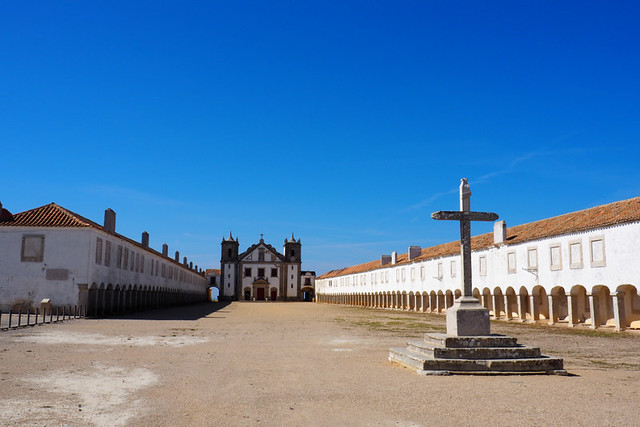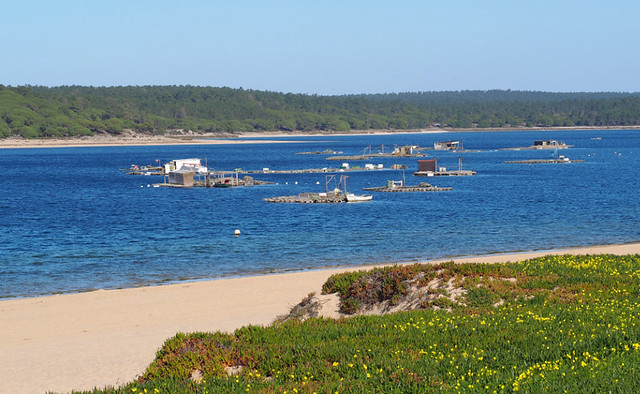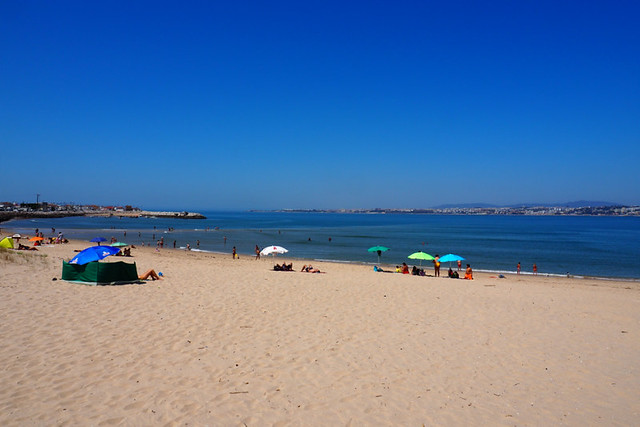Most of the time whenever we tell people in Britain we used to live near Setúbal in Portugal, a blank cloud floats across their faces. Explaining the Setúbal Peninsula is the chunk of land on the opposite side of the Tagus from Lisbon helps pinpoint its location. Few Brits, and other nationalities, tend to explore the Setúbal Peninsula, yet in summer its beaches are rammed with Portuguese holidaymakers. The ironic thing is that although most people who fly into Lisbon will gaze longingly down at the golden stretch of sand that lines almost the entire coastline south of the city, few will know its name. It is the Costa da Caparica.
Cabo Espichel
The south west face of the Setúbal Peninsula starts at a place we thought was rather special (I devoted a chapter to it in my book Camel Spit & Cork Trees), but which seemed to underwhelm anyone we took there, Cabo Espichel on the Costa Negra – the Black Coast – so called due to the dangers it posed passing ships. It’s not a pretty spot as such, but it is dramatic. What makes it special is the Sántuario de Nossa Senhora do Cabo Espichel, a religious folly that looks like it would make a great location for a remake of The Magnificent Seven. This remote spot once bustled with pilgrims to the extent it was virtually a small town, even boasting an opera house. How can anyone not be impressed by that? Add to this the dinosaur footprints in the surrounding cliffs, relatively easy to spot once you get your eye in, and it’s a fascinating location. There’s a café at the sanctuary, and food trucks often roll up at weekends, so a good spot to hang out for a couple of hours.
Lagoa de Albufeira
Head north and that golden strip of sand soon begins. Heading north isn’t quite as straightforward as it sounds. The roads in this part are of the maze variety, and finding your way to specific spots is time consuming and requires excellent navigational skills, even if utilising Sat Nav. But it’s worth the effort. Fabulous beaches are ten a centimo in Portugal, but the Lagoa de Albufeira stands out from the crowd as being a bit different. A huge lagoon sits just behind the golden sands, stretching inland for just under 4km. Its eastern end is a sanctuary for birds. In among the marsh willow are grebes, teal, ducks, cormorants, warblers, and kingfishers, whose Portuguese name guarda-rios describes these electrifying birds perfectly. On the lagoon are ramshackle islands consisting of floating huts; fishing is still a vital part of life here, and rows of fishermen can often be seen casting their lines from the shore.
The area of the lagoon closest to the Atlantic draws the greatest concentration of sunseekers. On a sunny January day, we had the beach virtually to ourselves, wandering into O Lagoeiro restaurant overlooking the lagoon for hearty portions of choco frito, chips, and tomato rice without a problem. But in summer months it is a different story.
Costa da Caparica
I’m not a big fan of Costa da Caparica, the northern stretch of the peninsula’s coast, and find it on the garish side, especially after the relative rural tranquillity of the south of the peninsula. For a start, it’s not uncommon to see prostitutes in the shade of stone pines by the roadside, a bizarre sight in a rural setting. Then, when it becomes more built up the further north you travel, the roads are lined with huge shacks selling everything you could think of connected with family beach holidays: from windbreaks and towels to balls, umbrellas, and enormous airbeds. Want a floating flamingo the size of a small boat? Costa da Caparica is the place to get it. Continuing north, the more it resembles any bog-standard resort area, albeit one for Portuguese rather than foreign visitors. The densely populated northern area of the Setúbal Peninsula is not particularly attractive, generally performing the role of an affordable place to live for people working in Lisbon. That’s not to say there aren’t plenty of surprising nuggets to be found, but to do so often requires negotiating confusing urban jungles.
There are mini oasis amid uninspiring architecture. After the tower blocks of Costa da Caparica, Trafaria, on the north west tip opposite Lisbon, has the laidback feel of a South American beachside pueblo.
The beaches on the Costa da Caparica are, admittedly, stunners, but in summer months virtually inaccessible … unless you’re happy to throw yourself into the madness. We did during August, once, finding ourselves crawling for miles and miles in a snake of traffic as everyone searched for the rare beast that was an empty parking spot within walking distance of the golden sands. It was oppressively hot, and the jammed dusty roads claustrophobic; we couldn’t wait to escape to the southern end of the coast which wasn’t anywhere like as manic.
It’s better to visit the area in spring and autumn, outside of holiday season, when it’s still hot enough for quality beach time, but without the crowds.







Be the first to comment